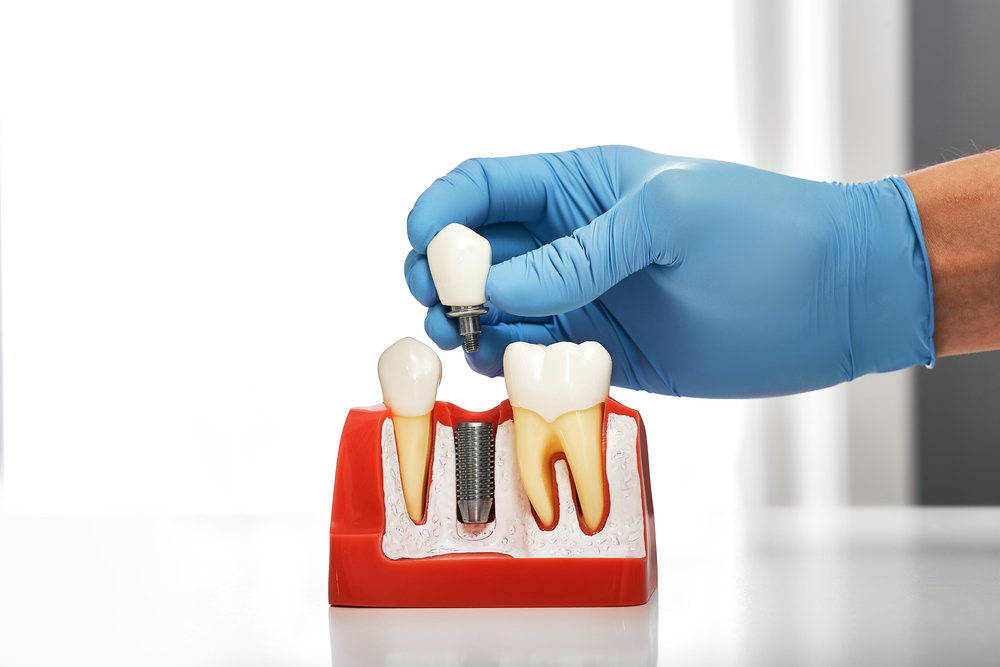

Dental implants are essentially artificial tooth roots, offering a permanent base for fixed, replacement teeth. Compared to dentures, bridges, and crowns, dental implants are a popular and effective long-term solution for people who suffer from missing teeth, failing teeth or chronic dental problems. They fit, feel and function like natural teeth, providing a strong foundation for eating, speaking, and smiling confidently.
What are Screw Retained Dental Implants?
Screw-retained dental implants are one type of dental implant where the crown is attached to the abutment with a screw rather than cement. The screw passes through the centre of the crown and can be removed if necessary, for example, for cleaning or replacement. The screw hole is usually filled with a tooth-colored filling material to make it less visible.
This type of implant offers a number of benefits. For one, it allows for the easy removal of the crown or the entire implant if necessary, without damaging the surrounding structures. This can be particularly useful if there is a need for repairs or adjustments. Secondly, there is no risk of residual cement being left behind, which can cause inflammation and other problems.
What are the Benefits of Screw Retained Implants?
Screw-retained implants offer several benefits. First, they provide a strong, stable, and secure connection between the implant and the artificial tooth. This ensures that the tooth will not become loose or fall out, providing patients with peace of mind.
Another benefit of screw-retained implants is that they require no cement. This eliminates the risk of cement-related complications, such as inflammation, infection, or damage to surrounding tissues. Additionally, any necessary adjustments or repairs can be easily performed without the need to remove or damage the implant. With proper care and maintenance, screw-retained implants can last a lifetime.
Understanding Cement Retained Dental Implants
Cement-retained dental implants, on the other hand, use a special type of dental cement to attach the crown to the abutment. The cement provides a strong, secure bond, ensuring that the crown remains in place. The cement is carefully applied to avoid excess cement from leaking out, which could potentially lead to inflammation or infection.
Despite the potential risk of excess cement, many dentists prefer cement-retained implants due to their aesthetic appeal. They allow for an uninterrupted, natural-looking crown, as there is no screw hole. Additionally, they are often easier to fit and adjust, particularly in areas where space is limited or the angle of the implant is not ideal.
Advantages of Cement Retained Implants
Cement-retained implants also have their unique set of advantages. One of the most significant benefits is the superior aesthetics they offer. With no visible screw holes, cement-retained implants often look more like natural teeth than their screw-retained counterparts.
Additionally, the cement used in these types of implants provides a strong, durable bond, ensuring the implant remains secure and stable. They also offer more flexibility in terms of positioning, which can be particularly useful in cases where the implant needs to be angled or positioned in a specific way to achieve the best aesthetic and functional results.
Screw Retained vs. Cement Retained: Comparative Analysis
When comparing screw-retained and cement-retained implants, it's essential to consider the specific needs and circumstances of the patient. Both types of implants have their benefits and drawbacks, and the best choice will depend on various factors, including the patient's oral health, the location and angle of the implant, and the patient's personal preferences.
Screw-retained implants offer the advantage of easy removal and maintenance, a lack of potentially problematic cement, and a strong, secure connection between the implant and the crown. However, they may not be as aesthetically pleasing due to the visible screw hole.
Cement-retained implants, on the other hand, offer superior aesthetics and greater flexibility in terms of positioning. However, they carry the risk of excess cement and can be more difficult to remove or adjust if necessary.
Making the Right Choice for Your Dental Health
Choosing the right type of dental implant is a crucial decision that will impact your oral health and quality of life for many years to come. Both screw-retained and cement-retained implants offer unique benefits and can provide a long-lasting solution to tooth loss.
The key is to understand the pros and cons of each type of implant and to discuss these thoroughly with your dentist. Together, you can make an informed decision that will ensure the best possible outcome for your dental health.
The ultimate goal of dental implants, whether screw-retained or cement-retained, is to restore function, enhance aesthetics, and improve your overall quality of life. Make sure to choose an option that best meets these objectives.
For more information on screw retained vs. cement retained dental implants, visit The Dental Laboratory Group at our Staten Island, New York office. Call (718) 477-6270 to schedule an appointment today.








